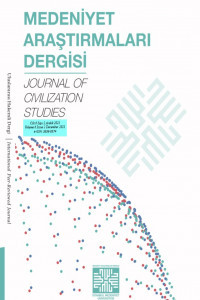ANALYZING SECULARISM MODELS: THE CASE OF TURKEY
This paper based on the literature review discussion on secularism models, aims to categorize Turkish model during the republican era. Since secularism is an ambiguous term, this study first aims to draw a structure about the meanings loaded on secularism; and then classifies different secularism models that modern secular states practice. After making a core categorization on that arena, this study analyses the historical background of Republican Turkey and categorizes its secularism experience into three terms. Turkey as a country that has gone through many changes very quickly experienced and gave many different connotations to what secularism is. By dividing Turkey’s history into three terms in this quest of giving meaning to what secularity should be, this paper investigates the stages and the theories together. While the first term is from the birth of the Turkish Republic to 1950 that is the date of transition to a democratic multi-party system, the second term involves the term from the 1950s to 2002 which witnessed the conflict of conservative parties and secular state bureaucracy with regards to the handling of secularism. This paper lastly, looks at AK Party period and how it transformed the notion of secularity into a passive and softer version of what it was before. The sphere of religious freedom and the close relationship it developed with secularity in AK Party period is also investigated and linked to Alfred Stepan’s Twin Toleration model and Jonathan Fox’s Separist Mode of Secularism.
Anahtar Kelimeler:
Models of Secularism, AK Party, Kemalism, Turkish Secularism
___
- Ardıç, Nurullah. (2012) Islam and the Politics of Secularism, New York: Routledge.
- Asad, T. (2003). Formation of the Secular: Christianity, Islam, Modernity. Stanford CA: Stanford University Press.
- Asad, T. (2006). “Trying to Understand French Secularism.”. In I. H. Vries (Ed.), Political Theologies in a Post-Secular World. New York: Fordham University Press.
- Aygenç, H. E. (2017). (Post-)Kemalist Secularism in Turkey. Journal of Balkan and Near Eastern Studies, 19(1), 70-85.
- Bader, V. (1999, October). Religious Pluralism: Secularism of Priority for Democracy. Political Theory, 27(5), 597-633.
- Barrett, D. B., Kurian, G. T., & Johnson, T. M. (2001). World Christian Encyclopedia (2 ed.). Oxford UK: Oxford University Press.
- Esbeck, C. H. (1988). A Typology of the Church-State Relations in Amerika Thought. Religion and Public Education, 15(1), 43-50.
- Huntington, S. P. (1996). The Clash of Civilizations and the Remaking of World Order. New York: Simon and Schuster.
- Grigoriadis, Ioannis N. (2009). Islam and democratization in Turkey: secularism and trust in a divided society, Democratization Journal, 16 (6), pp.1194–1213.
- Fox, J., & Sandler, S. (2004). World Separation of Religion and State in the Twenty-First Century. International Studies Association Conference. Montreal.
- Fox, J. (2011). Separation of Religion and State and Secularism in Theory and in Practise, Religion. State and Society, 39(4), 384-401.
- Madeley, J. T. (2004). European Liberal Democracy and the Principle of State Religious Neutrality. In J. T. Zsolt Enyedi, Church and State in Contemporary Europe (Vol. 26, pp. 1-22). London, Portland: Frank Cass.
- Öniş, Ziya. (2001) ‘Political Islam at the crossroads: from hegemony to co-existence’, Comparative Politics 7(4), pp. 281–298.
- Robert, J. B., & Rachel, M. M. (2005). Which Countries Have State Religions? Cambridge: Harvard University.
- Stepan, A. (2000). Religion, Democracy and the Twin Tolerations. Journal of Democracy, 11(4), 37-57. Tekeli, S. (1981) ‘Women in Turkish Politics’, in N. Abadan-Unat (ed.), Women in Turkish Society (Leiden: E.J. Brill). Zihnioğlu, Yaprak. (2003) Kadınsız İnkılap, (Revolution without Women) İstanbul: Metis Yayınları, 120-212.
- ISSN: 2148-1652
- Yayın Aralığı: Yılda 2 Sayı
- Başlangıç: 2014
- Yayıncı: İstanbul Medeniyet Üniversitesi
